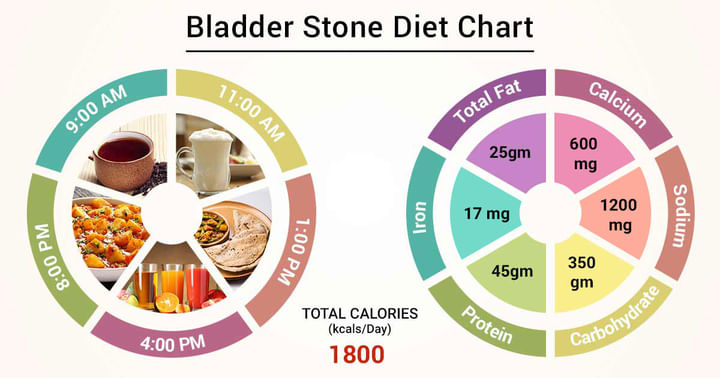Diet Chart For bladder stone
Last Updated: Jan 20, 2025
About
Bladder stone, not to be confused with kidney stones, are formed when minerals inside the bladder lump together and harden. This happens when the bladder doesn’t fully empty itself. For many, it may be symptomless. If small enough, they can easily be passed when urinating. But in some cases, you may experience symptoms like pain, difficulty urinating, increased urination, and visual changes in your urine. The good news is that bladder stones can be prevented through natural means and home remedies. Diet plays a large role in bladder stone development and prevention.
The primary cause of bladder stones is urine left in the bladder, but a diet can play a role in the formation of bladder stones too. This is because a poor diet can change the chemistry of your urine, increasing the risk of bladder stones. This is why, consuming a healthy bladder stone diet is so important to reduce your risk.
For starters, your bladder stone diet should be low in fat and contain a variety of nutrient-rich foods. This means consuming plenty of fruits and vegetables, whole grains, low-fat dairy, and lean sources of protein like poultry and fish.
Your diet should also be high in fiber, which can be obtained from whole grains and fruits and vegetables. You should consume plenty of water, as it can help flush out your bladder. Dehydration and insufficient water intake, on the other hand, can increase your risk of bladder stones as well. The goal is to aim for at least eight glasses of water a day, but this can vary.
Diet Chart
| Sunday | |
| Breakfast (8:00-8:30AM) | 1 cup skim milk/ tea+ 2 toasted bread/ 2 aloo stuff chapatti |
| Mid-Meal (11:00-11:30AM) | 1 cup buttermilk |
| Lunch (2:00-2:30PM) | 1 cup moong dal + 1 cup bhindi + 2 chapatti + salad |
| Evening (4:00-4:30PM) | 1 cup mix fruit juice + 2 biscuits |
| Dinner (8:00-8:30PM) | 1 cup dal + 1 cup potato curry + 1 cup rice + salad |
| Monday | |
| Breakfast (8:00-8:30AM) | 1 cup skim milk/ tea + 1.5 cup vegetable poha |
| Mid-Meal (11:00-11:30AM) | 1 cup watermelon |
| Lunch (2:00-2:30PM) | 1 cup rajma + 1 cup gobhi aloo + 1 cup cucumber raita + 1 cup rice + 1 chapatti + onion salad |
| Evening (4:00-4:30PM) | 1 cup lemonade + 1 toasted bread |
| Dinner (8:00-8:30PM) | 1 cup arhar dal + 1 cup methi mattar + 2 chapatti + salad |
| Tuesday | |
| Breakfast (8:00-8:30AM) | 1 cup skim milk/ tea + 2 vegetable moong dal cheela |
| Mid-Meal (11:00-11:30AM) | 1 cup watermelon juice |
| Lunch (2:00-2:30PM) | 1 cup chana dal + 1 cup soybean vegetable + 2 chapatti + salad |
| Evening (4:00-4:30PM) | 1 cup chana chaat + 1 cup lemonade |
| Dinner (8:00-8:30PM) | 1 cup moong dal + 1 cup ghia vegetable + 2 chapatti + salad |
| Wednesday | |
| Breakfast (8:00-8:30AM) | 1 cup skim milk/ tea + 2 besan cheela |
| Mid-Meal (11:00-11:30AM) | 1 cup buttermilk |
| Lunch (2:00-2:30PM) | 1 cup white chana + palak paneer + 1 cup rice + 1 chapatti + salad |
| Evening (4:00-4:30PM) | 1 soy chaap + 1 cup shikanji |
| Dinner (8:00-8:30PM) | 1 cup masoor dal + 1 cup snake gourd + 2 chapatti + salad |
| Thursday | |
| Breakfast (8:00-8:30AM) | 1 cup skim milk/ tea + 1.5 cup vegetable bread upma |
| Mid-Meal (11:00-11:30AM) | 1 cup papaya |
| Lunch (2:00-2:30PM) | 1 cup moong dal + 1 cup tinda vegetable + 2 chapatti + salad |
| Evening (4:00-4:30PM) | 1 cup vegetable soup |
| Dinner (8:00-8:30PM) | 1 cup soybean vegetable + 2 chapatti |
| Friday | |
| Breakfast (8:00-8:30AM) | 1 cup skim milk/ tea + 2 moong dal cheela + green chutney |
| Mid-Meal (11:00-11:30AM) | 1 cup cantaloupe |
| Lunch (2:00-2:30PM) | 1 cup palak dal + 2 chapatti + 1 cup ghia raita + salad |
| Evening (4:00-4:30PM) | 1 cup sprouts salad + 1 cup lemonade |
| Dinner (8:00-8:30PM) | 1 cup mattar paneer vegetable + 1 cup rice + salad |
| Saturday | |
| Breakfast (8:00-8:30AM) | 1 cup tea + 1 cup vegetable idli + 1 cup sambhar + coconut chutney |
| Mid-Meal (11:00-11:30AM) | 1 cup lemonade |
| Lunch (2:00-2:30PM) | 1 cup soybean curry + 1 cup rice + salad |
| Evening (4:00-4:30PM) | 1 cup pomegranate juice + 2 biscuits |
| Dinner (8:00-8:30PM) | 1 cup bhindi + 2 chapatti + salad |
Food Items To Limit
- Limit Animal Protein: Foods highest in purines include organ meats, such as liver, heart and kidney; anchovies; sardines; mackerel; codfish; herring; mussels; scallops; shrimp; veal; bacon.
- Avoid Sodium: Sodium may increase your risk of calcium oxalate and phosphate stones by causing your kidneys to excrete more calcium in the urine.
- Avoid Oxalate & Vitamin C: Limit the oxalate in your diet if you are at risk for calcium oxalate stones. Foods high in oxalate can increase levels in the urine. High-oxalate foods include spinach, beets, rhubarb, nuts, wheat bran, buckwheat and chocolate.
- Stone Promoting Fluids: Avoid sodas altogether to help reduce recurrence of stones. Drink mostly water and aim to consume between eight to 12 cups of fluid per day to help prevent all types of kidney stones.
- Foods High in Potassium: Kidney patients are advised to limit foods that are high in potassium, as these may lead to life-threatening complications such as heart failure. Tomato, potato, spinach, avocados, banana, orange and dried fruits should be limited.
- Caffeine and Alcohol: You need to limit caffeine and alcohol. Alcoholic and caffeinated beverages may initially increase urine output, but deplete your body water.
Do's And Dont's
Do's:
- Drink sufficient water/juices to excrete more than
- 5-2 liters of urine per day.
- Reduce consumption of protein food to a judicious level, as diet high in protein (e.g., meat fish, pulses, nuts and eggs) may lead to kidney stones.
- Decrease the consumption of sugar (e.g., sucrose)as sugar also promotes stone formation.
- Consume adequate amount of calcium every day. You can get enough calcium from food items like milk (120mg/100g), yogurt (120 mg/100g) and cheese (700mg/100g) reducing calcium intake may not decrease risk of stone formation but can lead to osteopenia. Moreover, reduced calcium consumption increases oxalate stone formation.
- Daily consume raw fruits such as melons, papaya, grapes, bananas, etc. in large quantity as they provide water soluble fiber.
- Be active and exercise regularly to lose your weight, which may be helpful to flush out better and maintain healthy functioning kidneys.
Don'ts:
- Avoid drinking a lot of coffee/tea and alcoholic beverages.
- Avoid too much drinking of carbonated drinks, sports drinks and sodas etc.
- Avoid highly salted (e.g., canned food, ready to eat food snacks, etc.) or sugared foods. High salt intake increases the level of calcium in urine and hence increases the risk of stone formation. This risk increases with the combination of high salt and high protein foods.
- Avoid oxalate containing foods including nuts, black tea, green leafy vegetables, soya and chocolates.
Food Items You Can Easily Consume
- Cereals: Brown rice, Oat meal, Brocken wheat, Ragi, Quinoa.
- Pulses: Chickpeas, Kidney beans, moong dal, masoor dal, soybeans.
- Vegetables: All gourds-bitter gourd, snake gourd, ridge gourd, bottle gourd, ivy gourd, ladies finger, tinda,green leafy vegetables.
- Fruits: Custard Apple, Pears, Grape and Watermelon, Orenges and Apple.
- Milk and Milk products: Skim milk, Paneer, Cotage Cheese, Yoghurt.
- Meat, Fish and Egg: Lean Meat, skin out chicken, Tuna, Salmon.
- Oil:
- 5 Tbsp/ day( Olive oil, Mustard Oil, Rice bran Oil, Canola oil
- Sugar: 1 Tsp/ day.
References
- Andersen DA. THE NUTRITIONAL SIGNIFICANCE OF PRIMARY BLADDER STONES 1. British journal of urology. 1962 Jun;34(2):160-77. [Cited 30 June 2019]. Available from:
- Scragg RK, McMichael AJ, Baghurst PA. Diet, alcohol, and relative weight in gall stone disease: a case-control study. Br Med J (Clin Res Ed). 1984 Apr 14;288(6424):1113-9. [Cited 30 June 2019]. Available from:
- Kok DJ. Metaphylaxis, diet and lifestyle in stone disease. Arab journal of urology. 2012 Sep 1;10(3):240-9. [Cited 30 June 2019]. Available from:
Table of content
Find Dietitian/Nutritionist near me
Ask a free question
Get FREE multiple opinions from Doctors



